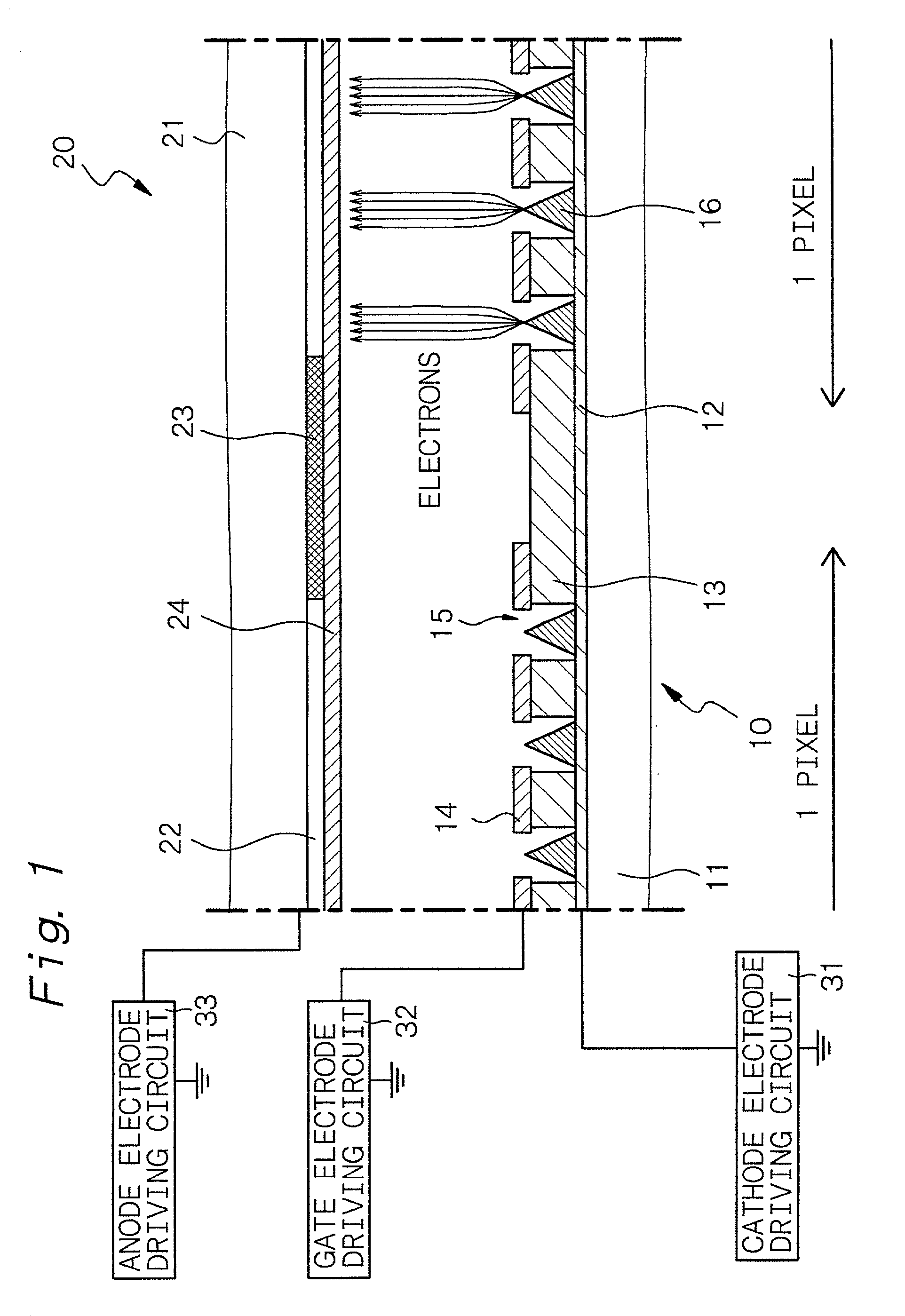Luminescence crystal particle, luminescence crystal particle composition, display panel and flat-panel display
- Summary
- Abstract
- Description
- Claims
- Application Information
AI Technical Summary
Benefits of technology
Problems solved by technology
Method used
Image
Examples
example 2
[0129] In Examples 2 to 12, various field emission devices will be explained. In Example 2, each electron-emitting region comprises a plurality of crown-type field emission devices. Display panels 20 in Example 2 and Examples 3 to 12 to be described later can be structurally the same as that in Example 1, so that detailed explanations thereof are omitted.
[0130] FIG. 9A shows a schematic partial end view of a field emission device having the first structure of a crown-type field emission device, and FIG. 9B shows a partial cut-off schematic perspective view thereof. The crown-type field emission device comprises a cathode electrode 12 formed on a substrate 11; an insulating layer 13 formed on the substrate 11 and the cathode electrode 12; a gate electrode 14 formed on the insulating layer 13; an opening portion 15 penetrating through the gate electrode 14 and the insulating layer 13; and a crown-type electron-emitting portion 16A formed on a portion of the cathode electrode 12 which ...
example 3
[0143] In Example 3, each electron-emitting region is constituted of a plurality of plane-type electron emission devices.
[0144] FIG. 10C shows a schematic partial cross-sectional view of a field emission device having the first structure of a plane-type field emission device. The plane-type field emission device comprises a cathode electrode 12 formed on a substrate 11 made, for example, of glass; an insulating layer 13 formed on the substrate 11 and the cathode electrode 12; a gate electrode 14 formed on the insulating layer 13; an opening portion 15 penetrating through the gate electrode 14 and the insulating layer 13; and a flat electron-emitting portion 16B formed on a portion of the cathode electrode 12 which portion is positioned in the bottom portion of the opening portion 15. The electron-emitting portion 16B is formed on the cathode electrode 12 in the form of a stripe extending in the direction perpendicular to the paper surface of FIG. 10C. Further, the gate electrode 14 ...
example 4
[0150] FIG. 11C shows a schematic partial cross-sectional view of a variant of the field emission device having the first structure of the plane-type field emission device. The plane-type field emission device shown in FIG. 11C differs from the plane-type field emission device shown in FIG. 10C in the structure of the electron-emitting portion 16B to some extent. The method for producing such a field emission device will be explained below with reference to FIGS. 11A, 11B and 11C showing schematic partial cross-sectional views of the substrate, etc.
[Step-400]
[0151] First, the electrically conductive material layer for a cathode electrode is formed on the substrate 11. Specifically, a resist material layer (not shown) is formed on the entire surface of the substrate 11, and then the resist material layer is removed from a portion where the cathode electrode is to be formed. Then, the electrically conductive material layer made of chromium (Cr) for a cathode electrode is formed on the...
PUM
 Login to View More
Login to View More Abstract
Description
Claims
Application Information
 Login to View More
Login to View More - R&D
- Intellectual Property
- Life Sciences
- Materials
- Tech Scout
- Unparalleled Data Quality
- Higher Quality Content
- 60% Fewer Hallucinations
Browse by: Latest US Patents, China's latest patents, Technical Efficacy Thesaurus, Application Domain, Technology Topic, Popular Technical Reports.
© 2025 PatSnap. All rights reserved.Legal|Privacy policy|Modern Slavery Act Transparency Statement|Sitemap|About US| Contact US: help@patsnap.com



